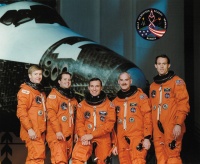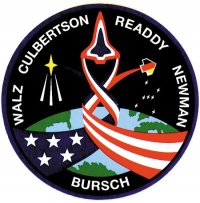STS-51
From The Space Library
 | |
| Organization | NASA-Office of Space Flight (United States), NASA-Office of Space Science Applications (United States) |
|---|---|
| Mission type | Astronomy,Communications,Human Crew |
| Launch date | September 12, 1993 |
| Launch vehicle | Space Shuttle |
| Launch site | Cape Canaveral, United States |
| COSPAR ID | 1993-058A |
| Inclination | 28.45 degrees |
| Experiments | Here |
| Alternate Names | 22795 |
| Additional Information | Here |
| PDMP Information | Here |
| Telecommunications Information | Here |
| Data Collection | Here |
| Payload Mass Up | 19360 kg |
| Payload Mass Down | 3894.09 kg |
| Orbiter | Discovery |
| Lift Off Mass | 2,057,213.64 kg |
| Orbiter Weight at Liftoff | 118,907.73 kg |
| Orbiter Weight at Landing | 93,835.45 kg |
| Landed | Concrete runway 15 at Kennedy Space Center, Fla. |
| Orbits of Earth | 158 |
| Orbital Altitude | 160 nautical miles (185 statute miles) |
Contents |
[edit] Crew
- Commander: Frank L. Culbertson Jr.
- Pilot: William F. Readdy
- Payload Commander:
- Mission Specialist 1: James H. Newman
- Mission Specialist 2: Daniel W. Bursch
- Mission Specialist 3: Carl E. Walz
- Mission Specialist 4:
- Mission Specialist 5:
- Payload Specialist 1:
- Payload Specialist 2:
ISS/Mir Crew Transport
[edit] Mission
STS 51 was the seventeenth flight of the Discovery orbiter. Its main mission goals were to deploy the Advanced Communications Technology Satellite (ACTS) and ORFEUS-SPAS. In addition to the the two spacecraft in the cargo bay, STS 51 also carried the Limited Duration Space Environment Candidate Materials Exposure (LDCE) experiment. Mid-deck experiments included the fourth flight of the Chromosome and Plant Cell Division in Space experiment (CHROMEX 4), the third flight of the Radiation Monitoring Equipment (RME-III), the Air Force Maui Optical Site (AMOS), the second flight of the Auroral Photography Experiment (APE-B), the Commercial Protein Crystal Growth (CPCG) experiment, the first flight of the High-Resolution Shuttle Glow Spectroscopy (HRSGS-A) experiment, the Investigations into Polymer Membrane Processing (IPMP) experiment, and more IMAX photography.
[edit] EVA
Extravehicular Activity (EVA) conducted by Carl E. Walz and James H. Newman, 7 hours, 5 minutes. Walz and Newman conducted tests in support of the Hubble Space Telescope first servicing mission and future EVAs, including International Space Station assembly and maintenance.
[edit] Payload
Advanced Communication Technology Satellite (ACTS)/Transfer Orbit Stage (TOS); Orbiting Retrievable Far and Extreme Ultraviolet Spectrometer - Shuttle Pallet Satellite (ORFEUS-SPAS) with Remote IMAX Camera System (RICS); Limited Duration Space Environment Candidate Materials Exposure (LDCE) (Beam Configuration C); Commercial Protein Crystal Growth (CPCG - Block II); Chromosome and Plant Cell Division in Space (CHROMEX); High-Resolution Shuttle Glow Spectroscopy-A (HRSGS-A); Auroral Photography Experiment-B (APE-B); Investigation Into Polymer Membrane Processing (IPMP); Radiation Monitoring Equipment (RME-III); Air Force Maui Optical Site Calibration Test (AMOS); IMAX In-Cabin Camera
[edit] Books about the Space Shuttle Program
Buy This Book Click here |
Buy This Book here |
Buy This Book Click here |
Buy This Book Click here |





